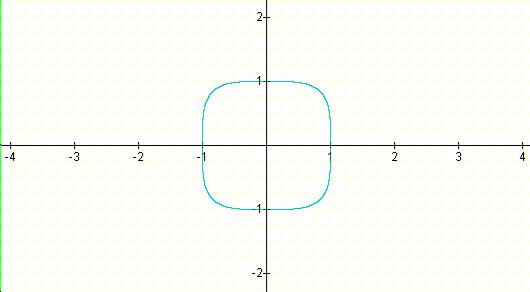

The graph of the above equation is a circle with the coordinate
of center c(0,0) and one unit radius. The domain of the relation
graphed above is all numbers between -1 and 1 included. The range
of this relation is the same as the domain. A quick vertical
line test reveals that the relation is not a function. To interpret
this relation, one can say that the sum of the square of the domain
and the square of the range is 1.
A close examination of the relation graphed above shows that
the the relation is a function with the domain and the range equal
to all real numbers.
Why this the range and the domain is all real numbers?
From the above table you can observe that a negative number
raised to an odd exponent produce a negative result
and any number raised to an even exponent is always positive.
There are unlimited numbers of combination of the sum of
the cube of two numbers which equal to 1.
The equation x^3 +y^3 =1 can be expressed as y = (1- x^3)^(1/3)
When x is a positive number greater than one, the expression in
parentheses is negative.
When x is a negative number less than one, the expression
in parentheses is positive.
When x is equal to one, the expression in parentheses is
0.
The equation x^2 +y^2 =1 can be expressed as y = (1- x^2)^(1/2)
and y = -(1 -x^2)^(1/2)
For any value of x greater than 1, the expression in parentheses
is negative. Therefore there is no real number value for
y.
this is the reason why the domain and the range of such equation
is all numbers between -1 and 1

x^2 + y^2 = 1 is the parent function of x^4 + y^4 =1
Hence, the equation equation x^4 +y^4 =1 can be expressed as y
= (1- x^4)^(1/4) and y = -(1 -x^4)^(1/4)
When the value of x is less than 0.5 then, the expression in parentheses
approaches 1
This graph has all the characteristic of the graph of x^3 +
y^3 = 1 , except that
the increase and the decrease in y goes in lower rate.
When the value of x is less than 0.9 then, the expression in parentheses approaches 1
Click HERE to see the animation
of: and